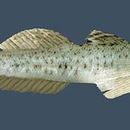Brief Summary
provided by Ecomare
The common goby is a small fish, no longer than 6.5 centimeters. It doesn't live very long, a maximum of 20 months. This fish is abundant in shallow channels in the Wadden Sea, where it feeds on gammarids and chameleon shrimp. When the temperature drops below 5°C, it migrates to the open sea.
- license
- cc-by-nc
- copyright
- Copyright Ecomare
Diagnostic Description
provided by Fishbase
This species is distinguished from other gobies in European freshwaters by the following characters: males with conspicuous dark proximal posterior spot on first dorsal; with cephalic lateral line canals; anterior oculoscapular canal extending to snout; branched rays in second dorsal 8-10.5; anal origin below simple of first branched ray of D2; total scales in midlateral series 39-52; completely scaled postdorsal body; caudal rounded (Ref. 59043). No scales in front of the first dorsal fin (Ref. 35388); body shape is terete, slightly depressed; eyes situated dorso-laterally; reduced swim bladders (Ref. 92840).
- Recorder
- Arlene G. Sampang-Reyes
Life Cycle
provided by Fishbase
Benthic spawner (Ref. 32023).
Migration
provided by Fishbase
Amphidromous. Refers to fishes that regularly migrate between freshwater and the sea (in both directions), but not for the purpose of breeding, as in anadromous and catadromous species. Sub-division of diadromous. Migrations should be cyclical and predictable and cover more than 100 km.Characteristic elements in amphidromy are: reproduction in fresh water, passage to sea by newly hatched larvae, a period of feeding and growing at sea usually a few months long, return to fresh water of well-grown juveniles, a further period of feeding and growing in fresh water, followed by reproduction there (Ref. 82692).
Morphology
provided by Fishbase
Dorsal spines (total): 6 - 8; Dorsal soft rays (total): 8 - 11; Analspines: 1; Analsoft rays: 7 - 10; Vertebrae: 30 - 32
- Recorder
- Arlene G. Sampang-Reyes
Biology
provided by Fishbase
Enters estuaries, salt marshes and pools (Ref. 4343); usually on sand or mud (Ref. 59043). Lives in sea as well as brackish waters and migrates into limnetic sections of rivers (Ref. 92840). Also rock pools where it feeds mainly on epibenthic meiofauna like harpacticoids and small amphipods (Ref. 92840); small crustaceans, worms, chironomid larvae and mites (Ref. 4696). Its burrowing habit allows it to survive low water levels and to avoid predators (Ref. 30508). Spawns after first winter, at sea, in February - September, depending on latitude; individual females spawn several times during a season. Adhesive eggs (0.9 x 0.7 mm) are deposited under or between stones, shells and aquatic plants and males guard the eggs until hatching. Juveniles enter freshwater habitats in late summer to forage (Ref. 59043). The male defends and aerates the eggs for about 9 days.
Importance
provided by Fishbase
fisheries: of no interest; aquarium: commercial
Common goby
provided by wikipedia EN
The common goby (Pomatoschistus microps) is a species of ray-finned fish native to fresh and brackish waters along the Atlantic and Baltic Sea coasts of Europe and northern Africa, with a range stretching from Norway to Morocco and Mauritania. It is also found in the Canary Islands. This species reaches a maximum length of 9 centimetres (3.5 in) TL.
Description
The common goby has two dorsal fins with a narrow gap between them, the anterior one consisting of six to eight spines and the posterior one eight to eleven soft rays. The pelvic fins are fused. There are 39 to 51 scales along the lateral line and these scales are slightly larger than those of the sand goby (Pomatoschistus minutus). The caudal fin is rounded. In males, there is a conspicuous dark spot on the anterior dorsal fin and dark markings at the base of the pectorals and the caudal fin. Otherwise the colour is light grey or sandy brown with indistinct dark markings and dark striations on the pale fins. The colour of the male darkens during the breeding season and his fins become more coloured. The average size is about 4 to 5 cm (1.6 to 2.0 in)[2] with a maximum of about 9 cm (3.5 in)[3]
Habits
The common goby breeds from February to September, laying its eggs under shells, stones or on aquatic plants. The male then guards the eggs until they hatch about nine days later. Common gobies can live for up to three years. They inhabit sandy- or muddy-bottomed shallow areas in estuaries or brackish lagoons at depths of from 0 to 12 metres (0 to 39 ft). Their diet is mostly small crustaceans, worms, harpacticoids, amphipods, chironomid larvae and mites.[3] The common goby is normally found in similar locations but shallower water than the sand goby.[2]
References

- license
- cc-by-sa-3.0
- copyright
- Wikipedia authors and editors
Common goby: Brief Summary
provided by wikipedia EN
The common goby (Pomatoschistus microps) is a species of ray-finned fish native to fresh and brackish waters along the Atlantic and Baltic Sea coasts of Europe and northern Africa, with a range stretching from Norway to Morocco and Mauritania. It is also found in the Canary Islands. This species reaches a maximum length of 9 centimetres (3.5 in) TL.
- license
- cc-by-sa-3.0
- copyright
- Wikipedia authors and editors

